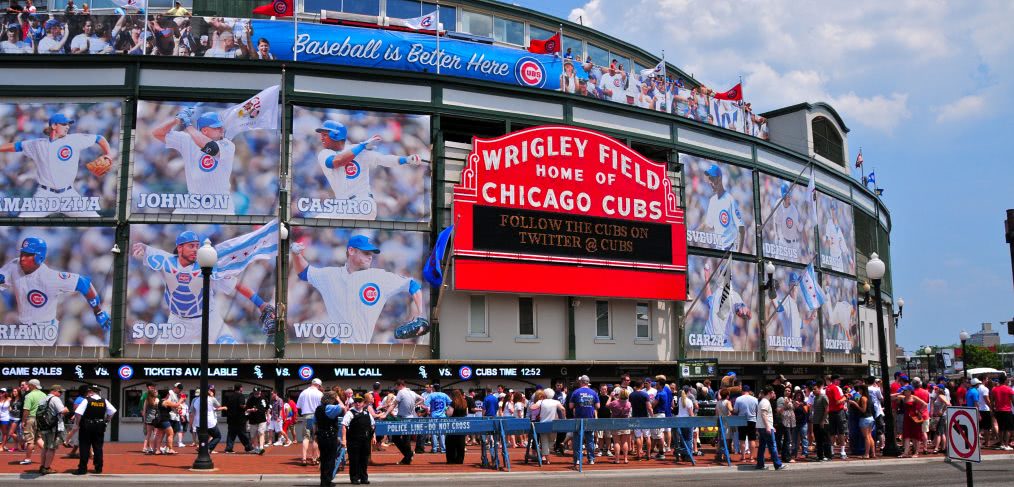
It Takes A Ville
CRTKL’s Keith Campbell talks Chicago, the World Series and the design of Wrigleyville.
The stately lions at the steps of the Art Institute of Chicago are wearing Cubs caps. The brachiosaurus dinosaur skeleton in front of the Field Museum of Natural History is wearing a Cubs jersey. The dive bars around Clark and Addison are charging $150 covers. Yeah, you could say we’re excited about the hosting the World Series for the first time in 71 years.
Lost in our once-in-a-century euphoria is an appreciation of Wrigleyville, the grandfather of all sports oriented mixed-use districts. Before we even pretended to know what makes a mixed-use district thrive, Wrigleyville showed us.
Wrigley Field never had any decent parking, thank God. No parking decks, no acres of asphalt. Just a few friendly three-flat owners that might let you park in their garage or alley for the right price. How could a 40,000-seat stadium exist, much less thrive, with no parking?
Thank our city fathers for that, especially the Chicago Transit Authority. Wrigley Field is served by the Red line, the Purple Line express and three bus lines. The streets are walkable, vibrant, alive, historic and adaptable. The Walk Score for 1044 W. Addison is 94, and had Walk Score been invented in 1914 it would have been 94 then, too. Both Wrigley Field and the CTA provide ample bike parking, and on game days the bike racks are overflowing.
The stadium itself is wedged snugly into a city block, so most of the adjacent sidewalks are modestly scaled, to say the least. Across the street from the stadium are a historic fire station, taverns, restaurants, three-flats and courtyard apartments. In other words, the kind of fine-grained urbanism most of us hope to enjoy even without a major league attraction in the mix.
Proximity and adjacencies matter, too. A 20 minute walk from Wrigley will get you to the Chicago lakefront, a 20-mile long greenspace planned and protected by Burnham’s 1909 Plan of Chicago. There are no gaps, no missing teeth, no eyesores between Wrigley and the Lake. Although the Wrigleyville boundaries are subject to personal bias, no matter how you define it, it is surrounded by other vital pockets with equal magnetism: Buena Park, Boystown, West Lakeview, Lincoln Square, Roscoe Village, St. Ben’s. That magnetism is not lost on the players, as both benchwarmers and superstars live in the ‘hood and walk or ride their bikes to work. Even Theo Epstein walks his dog in the 7-block stretch between his house and the field.
The Wrigleyville population is stable, around 120,000, and hasn’t changed much for decades. The prevalent housing typologies are single family; two-, three-, and four-flats, and four- to six-story courtyard apartments, originally built as workforce housing. Despite the miserable reputation of Chicago Public Schools in general, there are many public K-8 schools with waiting lists in Wrigleyville, and Lane Tech high school, a brick behemoth with over 4000 students just down the street, has maintained a reputation for excellence since it opened in 1908, the last time the Cubs won the World Series.
Go to any Cubs away games and you’ll feel the influence of the Cubs brand. Cubs fans, lots of them, show up at every MLB park in the country. Sure, Lovable Losers and the Curse of the Goat aren’t exactly positive, but those things were always negated by the most important attribute of Wrigleyville: a positive urban experience. For years, the criticism of the Cubs ownership was that they would never bother to develop a winning tradition because fans would flock to the games anyway, win or lose. Non-baseball entertainment is plentiful here. Murphy’s Bleachers, the Cubbie Bear, Yak-zie’s, Slugger’s,— hey, this place is fun!
Mixed-use neighborhoods must adapt to change. As the Wrigleyville demographics have changed, the physical environment has remained remarkably consistent because the building blocks of responsible urbanism were established early. The current owner of the Cubs, the Ricketts family, have spent millions on improvements to the stadium, and on adjacent redevelopment projects which are in turn triggering additional investment in the neighborhood. So far, these improvements are admirably restrained and have clearly been designed with the protection of the Wrigleville experience in mind.
Public Transportation, walkable streets, appropriately scaled public realm, entertainment, a stable residential population, good schools, a global brand. It worked in 1914, and it works now.
